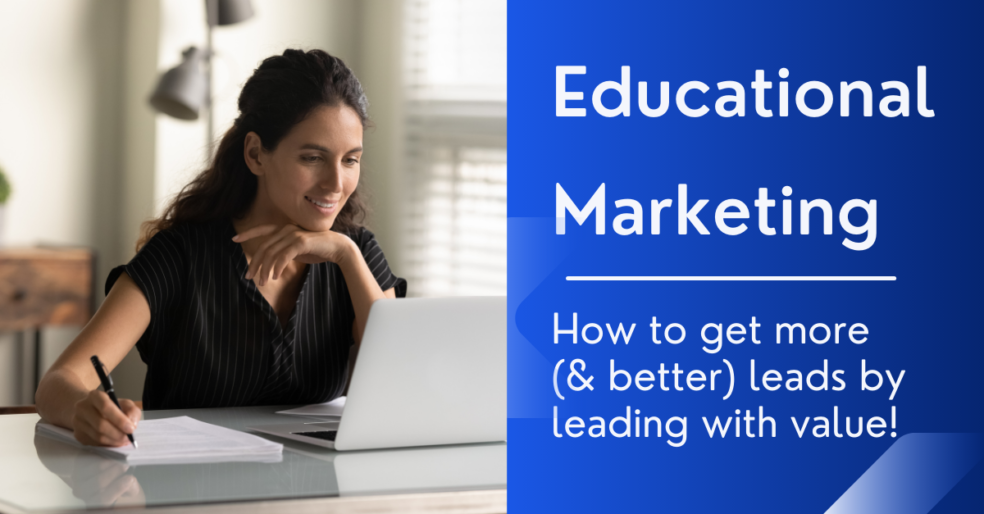Traditional lead generation means first establishing a target market, and then reaching out to ask “Does our product/service interest you at the moment?”
If the prospect says Yes , then we commence with a tried-and-true sales process.
Set a discovery call → Make the pitch → Answer questions → Field objections → Close the deal.
Most of the time, this approach works splendidly. But there are certain circumstances in which a traditional direct pitch tends to fall flat.
When to use an Educational Lead Generation Approach
In an average market about 10% of the people are open to a buying conversation. On average, that’s how many people are in-market.
Up to 60% of prospects will accept an invitation to learn about a problem or solution, however. That’s 2x as much lead potential.
Every salesperson is looking for buyers, but if the number of people in-market is too small, then you’ll never have enough sales opportunities to move the needle.

Red Flags
Here are some early indicators that a direct sales approach isn’t appropriate.
🚩 The value offer is complex or new to the industry.
🚩 The product requires customization.
🚩 The client/vendor relationship requires personality compatibility.
🚩 The market is over-saturated and competitive
🚩 Your target industry has low levels of awareness when it comes to your product or service
In these special cases, the prospect needs an additional nurturing phase before they’ll be ready to sign a contract or write a check. They need to get more familiar with the product, service, and vendor.
Here at Speedwork, we accomplish this by using an Educational Lead Generation Approach. In this case, the seller shifts their goal from establishing interest in the product to establishing interest in learning about the product.
Avenues for Prospect Education
Most often, the learning opportunity comes in the form of a free educational resource. It’s important that this resource be self-contained, clearly defined, and easy to share with the prospect via a link, document share, or invitation.
Some examples of an educational resource include:
- An e-book
- A whitepaper
- A series of educational emails, videos, or modules
- A webinar
- An in-person presentation (given that geography is not an issue)
- Early/special access to an upcoming publication, feature, or product
- Free trials or product pilots
How does education solve the red-flag problem?
📗 The educational resource takes a complex, intangible offer and makes the added-value clear to the prospect
📗 The educational resource offers use-case examples and testimonials so that the prospect can see themselves in your clients’ shoes
📗 As they learn about the product, the client familiarizes themselves with the business owner who is making the presentation. This helps build trust and establishes compatibility.
📗 The educational resource differentiates the product or service from others in an over-saturated market.
🌟 Most importantly, it’s much easier for a prospect to say YES to a free resource than to a sales call. And once they’re interested, then you can start your sales process.
Other benefits of Prospect Education…
🌟 The educational resource acts as a filter to remove any prospects who wouldn’t be a fit for your service
🌟 Presentations (virtual or in-person) allow the business owner to start a sales conversation with hundreds of prospects at once, saving time and money.
🌟 The educational content makes a smooth and rich talking point for you to chat about with the prospect one-on-one.
🌟 Time spent together with the prospect aids in building trust, which is especially important in industries that require a transfer of confidential information—think financial services, cybersecurity, etc.
What’s next?
Once you’ve given your prospect access to the educational resource, the first step is to give them time to process what they’ve learned. But stay in contact with them, so that they don’t push the PDF down on their to-do list.
Then, it’s time to start pounding the pavement and chatting with those who opted into your presentation. We’ve seen that a traditional lead-gen approach works wonders on prospects who have already been through an educational sequence.
Closing the deal
Use these tips as a starting point:
✅ Ensure that there is ample contact information included in your educational resource. This allows some prospects to become inbound leads. (Plus, you’d be surprised how many pass it to a better-suited colleague and do that leg work for you.)
✅ Ask each prospect what they thought about your resource, and whether they had any questions. If possible, do this on the original platform that you used to make contact.
✅ Ask the prospect what is holding them back from becoming your customer, then field the objections.
✅ Consider implementing a discount or promotion in the weeks after your presentation or resource-share. This will establish FOMO and help make the buying decision easier.
✅ Place the prospect into an ongoing communication channel so that you don’t lose contact. Think email newsletter, social media, or even your CRM.
✅ When appropriate, send a calendar link and set an appointment for a discovery call.
Now that there are no more red flags, the field is clear for you to start closing deals. Good luck!
